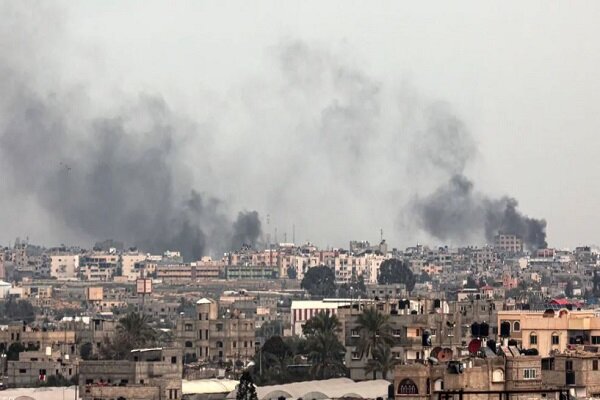The full text of the ceasefire agreement between Hamas and the Zionist regime

According to Mehr News Agency Palestinian “Ma’a” wrote about this agreement: This agreement, which was mediated by Qatar, America and Egypt and will be implemented from Sunday, January 19 (January 30), is mostly related to the mechanism of the first stage, which lasts 42 days and during which 33 Zionist prisoners (either alive or body) are handed over.
“The general principles of the agreement between the Israeli and Palestinian parties in Gaza on the exchange of prisoners and the establishment of a lasting ceasefire” are as follows:
All Israeli prisoners, both dead and alive, captured by the resistance will be released, and in return the Israeli regime agreed to release an agreed number of Palestinian prisoners.
Exchange will begin on Armistice Day, the day specified in the Agreement as “Day One”.
The Israeli regime and Hamas also called for a ceasefire that would lead to four goals, “permanent ceasefire”, “withdrawal of Israeli forces from the Gaza Strip”, “Gaza reconstruction”, “reopening of crossings and facilitating the movement of people and the transportation of goods.” It is possible, they agreed.
The terms of the agreement according to three stages are as follows:
First stage (42 days):
Temporary cessation of military operations on both sides and the withdrawal of the Israeli army to the east from “populated areas along the border in all areas of the Gaza Strip, including the Gaza Wadi (Netsarim axis).
Temporary suspension of air traffic (military and surveillance) in the Gaza Strip for 10 hours a day and 12 hours on the days in which the exchange of prisoners takes place.
Return of the refugees to their place of residence and exit from the Gaza Wadi.
And on the seventh day (after the release of seven Zionist prisoners), the forces of the occupying Israeli regime completely retreat from Al-Rashid coastal road to the east to Salahuddin road.
Israel pledged to completely destroy its bases and military installations in this area, and thus the return of refugees to their places of residence (without carrying weapons) will begin. The freedom of movement of people in all areas of the Gaza Strip will be unrestricted and the entry of humanitarian aid will be unrestricted from the first day.
On the 22nd day, Israeli forces will withdraw from the center of the Gaza Strip (especially the Netsarim axis east of the Salah al-Din road to the area along the border) and military bases and installations will be completely dismantled.
>
From the first day, humanitarian aid will be allowed (600 trucks per day, including 50 fuel trucks, 300 of which belong to the northern Gaza Strip). This includes the fuel needed to run the power plant and the commercial and construction equipment needed to remove the debris and rebuild and run the hospital.
Exchange of prisoners:
Hamas will release 33 Israeli prisoners (civilian women and soldiers), children (under 19 years old and nine soldiers), adults (over 50 years old), sick and wounded civilians.
On the other hand, the Zionist regime will release a number of Palestinian prisoners. Considering the lists provided by Hamas based on the priority of their arrest, the Israeli regime will release 30 Palestinian women and children for every woman or child released by Hamas.
Also, according to the list provided by Hamas based on the priority of their arrest, in exchange for the release of every elderly and sick Zionist by Hamas, Israel will release 30 adult and sick prisoners (with up to 15 years of their captivity remaining). does.
For every female soldier released, Israel releases 50 Palestinian prisoners (30 serving life sentences and 20 serving sentences of up to 15 years).
This is subject to the lists provided by Hamas, except for the agreed list. The number of Palestinian prisoners (at least 100 people) that will be discussed in the second stage. Some of them will be released and deported abroad or to Gaza.
Prisoner exchange mechanism between the two sides in the first stage:
Hamas will release three Israeli civilians on the first day and four more on the seventh day. After that, Hamas will release three Israeli prisoners every seven days, starting with women.
It was decided that all living Israeli prisoners will be released before the bodies, and Hamas will release all remaining prisoners at this stage in exchange for the release of the agreed number of Palestinian prisoners in Israeli prisons in the sixth week. This release is done simultaneously and based on the lists provided by Hamas.
By the seventh day, Hamas will provide information about the number of Israeli prisoners that will be released at this stage.
In the sixth week (after the release of Hisham al-Sayed and Afra Mengisto, who join the total of 33 Israeli prisoners), Israel will release 47 prisoners who have been recaptured from the Shalit contract (the name of the Israeli prisoner). /p>
If the number of living Israeli prisoners who are to be released at this stage does not reach 33 people, by returning the bodies of those groups, this number will be completed, and on the other hand, in the sixth week, the Israeli regime will release all women and children (under 19 years of age and non-combatants) ) who were arrested in the Gaza Strip after October 7.
Israel pledged not to re-arrest the freed Palestinians on the same charges and will not attempt to return the freed Palestinian prisoners to serve the remainder of their sentences.
It was also agreed that the freed Palestinians would not be required to sign any document as a condition of their release.
The two sides agreed that the opening of the exchange of the above-mentioned prisoners will not be considered as a basis for the opening of the exchange in the second stage of the deal.
No later than the 16th day, indirect negotiations between the two sides will begin to agree on the conditions for the implementation of the second stage, especially those related to the opening of the exchange of prisoners.
Negotiations will be completed and agreed upon by the end of the fifth week of this stage.
The United Nations, its agencies and other organizations will continue to provide humanitarian services in all areas of the Gaza Strip.
Start rebuilding infrastructure (electricity, water, sewerage, communication and roads) throughout the Gaza Strip and bringing in the agreed amount of equipment needed for civil defense (relief agencies).
Facilitating the arrival of supplies and necessities for the settlement of displaced people who lost their homes in the war. At least 60,000 caravans and 200,000 tents will arrive.
After the release of all female Israeli soldiers, a number of Hamas wounded are assigned to go to the Rafah crossing for treatment. In addition, the number of passengers, sick and injured through the Rafah crossing will increase and travel restrictions will be lifted and the movement of goods and trade will resume.
The adoption of necessary measures and programs for the comprehensive reconstruction of houses, civilian facilities and civilian infrastructure destroyed during the war and to support the victims will be started under the supervision of a number of countries and organizations, including Egypt, Qatar and the United Nations.
>
All the actions in this phase, i.e. the military ceasefire, will continue in the second phase as long as the negotiations on the terms of its implementation continue.
In this agreement, it is specified that Qatar, the US and Egypt will do their best to ensure the continuation of indirect negotiations until the two sides can agree on the terms of the implementation of the second phase.
Second stage (42 days):
A permanent ceasefire (stopping military operations and acts of aggression in an orderly manner) will be announced and will begin before the exchange of prisoners.
The agreement states: We are talking here about all surviving Israeli prisoners, in exchange for the release of a number of Palestinian prisoners in Israel. At this stage, the complete withdrawal of the Israeli army from the Gaza Strip will take place.
Third stage (42 days):
Exchange of all bodies between the two sides after determining their location and identification.
The implementation of the 3 to 5-year reconstruction plan of the Gaza Strip, including housing, urban facilities, civilian infrastructure and support for victims, will begin under the supervision of countries and organizations including Egypt, Qatar and the United Nations.
Reopening border crossings and facilitating the movement of people and goods.


